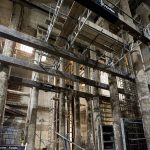Think of tourist hotspots in London and you’ll likely think of Camden Town. Situated by the Regent’s Canal and known for its market that is almost as vibrant as its nightlife, it is unsurprising that the area is as popular with tourists and teenagers as it is punks, with 500,000 people passing through Camden daily. Right in the heart of Camden high street, ASUC member MJ Rooney Construction Ltd built new basements units underneath 5 adjacent commercial units. Each basement has been formed 4m below the street level while the residential units above the project were still occupied.
Owing to the location of the project, several factors had to be given special consideration. The central pillars and historic corbels above the shop fronts had to be protected to maintain the historic look of the high street, a robust scheme was to be required while forming the new sub terrain structure.
Working together
Alongside these issues, M J Rooney also had to ask themselves, “How do you mitigate the risk of disrupting the journey of 225,000 passengers on the Northern Line?” Party wall surveyors and checking engineers working on behalf of Camden Council and London Underground gave particular scrutiny to the scheme as the Northern Line tunnel was one of the adjacent structures to the proposed basement.
To address these issues, the project needed a collection of different construction techniques in order to form the shell and MJ Rooney Construction were called in at early design stage to formulate a scheme that would deliver a cost- and time-effective design. They devised three different underpinning sequences, a piled wall solution with restricted access and top down construction that ensured the support of adjacent buildings whilst forming a retaining wall to London Underground Northern Line’s tunnels running right under the high street.
As no damage to the adjacent structures were permitted, MJ Rooney monitored all the surrounding structures throughout the project, carrying out both level monitoring and lateral movement monitoring. Measurement throughout the whole process of underpinning and structural movement was less than 4mm in all locations. Unit specific floor replacement sequences were developed with the help of the 3D models. They analysed which sequence was best without putting the lateral stability of the building into jeopardy and found that the lines of the shell were far from ideal square boxes. As they were working with the historical design of the units, M J Rooney developed several tailored underpinning shafts to work around small nibs, old chimney shafts and external corners.
Innovation and problem solving
M J Rooney also used innovative technologies and procedures to prepare for the project, using VR in training and new approaches to model-making. In particular, they created 4D models that factored the effects of time and actual site conditions into 3D models. The model helped them to identify future problems and test possible solutions on the model, allowing them to identify areas in which they could save their client’s time and cost. Considering the potential disruption to the public and the tenants and also financial consequences caused by delays, they were very keen to shorten the programme where possible.
In house technologies also presented the opportunity to develop an innovative bracket designed to ensure minimal structural movements during underpinning works and maximise safety of underpinning operatives. The minimal downward movement tolerance was the first thing MJ Rooney wanted to tackle before they excavated the first pin. This is a common issue in the entire industry as the masonry walls are fully exposed during the formation of underpinning shafts. They developed a bracket system to be installed under the exposed section of masonry wall and provide support during the underpinning process spanning between the adjacent wall sections.
This project demonstrates the adaptability and ingenuity of ASUC member companies. It is no surprise that this project was awarded the ASUC Project of the Year Award in the category ‘Large’ in November 2018.






